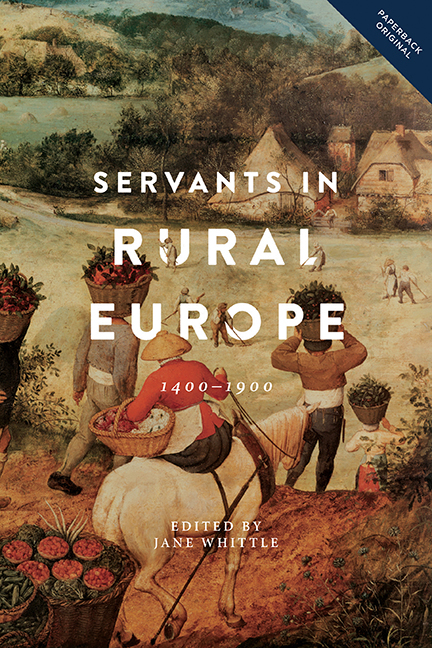Book contents
- Frontmatter
- Contents
- List of Figures
- List of Tables
- Note on Terminology
- List of Contributors
- Introduction: Servants in the Economy and Society of Rural Europe
- 1 The Employment of Servants in Fifteenth- and Sixteenth-Century Coastal Flanders: A Case Study of Scueringhe Farm near Bruges
- 2 The Institution of Service in Rural Flanders in the Sixteenth Century: A Regional Perspective
- 3 A Different Pattern of Employment: Servants in Rural England c.1500–1660
- 4 Female Service and the Village Community in South-West England 1550–1650: The Labour Laws Reconsidered
- 5 Life-Cycle Servant and Servant for Life: Work and Prospects in Rural Sweden c.1670–1730
- 6 Servants in Rural Norway c.1650–1800
- 7 Rural Servants in Eighteenth-Century Münsterland, North- Western Germany: Households, Families and Servants in the Countryside
- 8 Rural Servants in Eastern France 1700–1872: Change and Continuity Over Two Centuries
- 9 The Servant Institution During the Swedish Agrarian Revolution: The Political Economy of Subservience
- 10 Farm Service and Hiring Practices in Mid-Nineteenth-Century England: The Doncaster Region in the West Riding of Yorkshire
- 11 Dutch Live-In Farm Servants in the Long Nineteenth Century: The Decline of the Life-Cycle Service System for the Rural Lower Class
- 12 Rural Life-Cycle Service: Established Interpretations and New (Surprising) Data – The Italian Case in Comparative Perspective (Sixteenth to Twentieth Centuries)
- Select Bibliography
- Index
- People, Markets, Goods: Economies and Societies in History
9 - The Servant Institution During the Swedish Agrarian Revolution: The Political Economy of Subservience
Published online by Cambridge University Press: 18 April 2018
- Frontmatter
- Contents
- List of Figures
- List of Tables
- Note on Terminology
- List of Contributors
- Introduction: Servants in the Economy and Society of Rural Europe
- 1 The Employment of Servants in Fifteenth- and Sixteenth-Century Coastal Flanders: A Case Study of Scueringhe Farm near Bruges
- 2 The Institution of Service in Rural Flanders in the Sixteenth Century: A Regional Perspective
- 3 A Different Pattern of Employment: Servants in Rural England c.1500–1660
- 4 Female Service and the Village Community in South-West England 1550–1650: The Labour Laws Reconsidered
- 5 Life-Cycle Servant and Servant for Life: Work and Prospects in Rural Sweden c.1670–1730
- 6 Servants in Rural Norway c.1650–1800
- 7 Rural Servants in Eighteenth-Century Münsterland, North- Western Germany: Households, Families and Servants in the Countryside
- 8 Rural Servants in Eastern France 1700–1872: Change and Continuity Over Two Centuries
- 9 The Servant Institution During the Swedish Agrarian Revolution: The Political Economy of Subservience
- 10 Farm Service and Hiring Practices in Mid-Nineteenth-Century England: The Doncaster Region in the West Riding of Yorkshire
- 11 Dutch Live-In Farm Servants in the Long Nineteenth Century: The Decline of the Life-Cycle Service System for the Rural Lower Class
- 12 Rural Life-Cycle Service: Established Interpretations and New (Surprising) Data – The Italian Case in Comparative Perspective (Sixteenth to Twentieth Centuries)
- Select Bibliography
- Index
- People, Markets, Goods: Economies and Societies in History
Summary
The life-cycle servants of the pre-industrial, agrarian Swedish society could be described as an ‘elegant solution’ to the changing balance between labour power and dependants that a farming household experienced during its existence. Time spent in service also made it possible to earn a living until the prerequisites of marriage and setting up a new farming household became available, which is a part of the model that John Hajnal described as the European marriage pattern. Sweden was characterized by this pattern from at least 1750. However, the strict regulations which forced landless people into year-long contracts as live-in servants suggest that economic and demographic forces were not enough to make young people take up positions as servants.
The bases of the life-cycle servant system were challenged during the agrarian revolution, when a process of proletarianization rendered it more difficult to reach the position of a landed farmer after a period of service. Proletarianization refers to the process of a larger share of the population being obliged to sell their labour power instead of controlling their means of production, that is, land in the agrarian society. This left larger groups than ever permanently landless and a lifelong position as wage labourer became a threat as well as a possibility for larger groups in agrarian Sweden.
The aim of this study is to analyse how the power relations between servants and their masters and mistresses in the peasantry were understood and changed during this process, both as a labour market and as a gendered contract.
In 1700, Sweden had 1.4 million inhabitants, which had increased to 2.4 million at the end of the century. In 1870 the figure was 4.2 million people. The vast majority lived in rural areas and up to 1850 about 80 per cent of the population made their living predominantly from farming-related activities. The agrarian revolution took place in Sweden c.1750–1850 and involved population growth, clearing of land, the use of new tools and farming techniques, and new forms of ownership which created more efficient agriculture, as well as increased social stratification among the rural population. Between 1750 and 1860 the number of landed farmers increased by 10–20 per cent, while the landless group at least quadrupled in number.
- Type
- Chapter
- Information
- Servants in Rural Europe1400–1900, pp. 167 - 182Publisher: Boydell & BrewerPrint publication year: 2017

